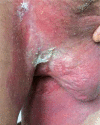Psoriasis in special localizations
- PMID: 30647487
- PMCID: PMC6330687
- DOI: 10.5114/reum.2018.80718
Psoriasis in special localizations
Abstract
Psoriasis is a chronic inflammatory dermatosis affecting 1-3% of the general population. Patients with psoriasis represent a heterogeneous population with individual disease expression - different degrees and severity of skin involvement. Psoriatic lesions in particular localizations such as the face, scalp, intertriginous or palmoplantar areas significantly reduce quality of life. Patients often feel ashamed, embarrassed, or self-conscious about their symptoms. Furthermore, genital psoriasis significantly affects sexual health. Among patients with psoriasis, the prevalence of special localizations is estimated to be 23-27% on the nails, 49% on the face, 12-16% on the palms and soles, and up to 36% in intertriginous regions. Due to peculiar features of skin in these areas, adequate and specific management is required, which is discussed in this review.
Keywords: facial psoriasis; genital psoriasis; palmoplantar psoriasis; scalp psoriasis; special localization.
Conflict of interest statement
The authors declare no conflict of interest.
Figures
References
-
- Michalek IM, Loring B, John SM. A systematic review of worldwide epidemiology of psoriasis. J Eur Acad Dermatol Venereol. 2017;31:205–212. - PubMed
-
- Reich A, Adamski Z, Chodorowska G, et al. Psoriasis Diagnostic and therapeutic recommendations of the Polish Dermatological Society. Part I: Mild psoriasis. Dermatol Rev/Przegl Dermatol. 2018;105:225–243.
-
- Aldredge LM, Higham RC. Manifestations and Management of Difficult-to-Treat Psoriasis. JDNA. 2018;10:189–197.
-
- Frez ML, Asawanonda P, Gunasekara C, et al. Recommendations for a patient-centered approach to the assessment and treatment of scalp psoriasis: A consensus statement from the Asia Scalp Psoriasis Study Group. J Dermatolog Treat. 2014;25:38–45. - PubMed
Publication types
LinkOut - more resources
Full Text Sources





